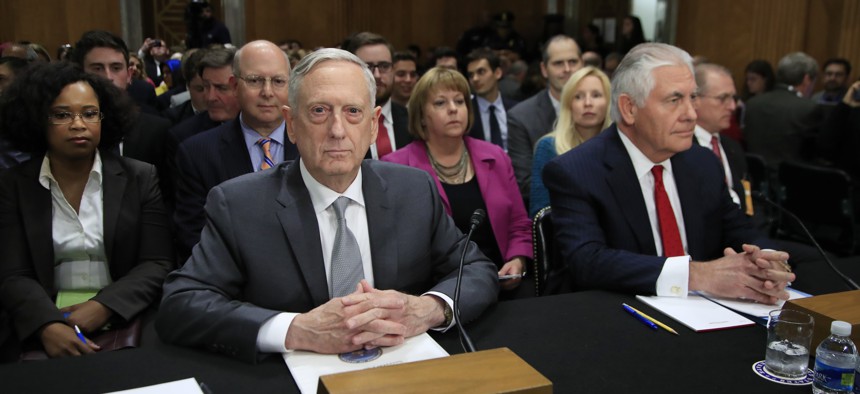
Secretary of Defense Jim Mattis and Secretary of State Rex Tillerson are seated during a Senate Foreign Relations Committee hearing on Capitol Hill in Washington, Oct. 30, 2017. Manuel Balce Ceneta/AP
DoD is Losing the Budget Endgame
Lawmakers have prioritized tax cuts, and now there’s just one way left for the defense budget to recover.
The fiscal year 2018 budget endgame has begun, and it doesn’t look good for the Department of Defense. There have been hopeful signals all year. The Administration’s base budget request came in at $574.5 billion, $52 billion above the Budget Control Act caps. The House and Senate passed defense authorization bills that far exceeded that mark, and the House even passed an appropriations bill that provided $18 billion more than the request.
The casual observer is forgiven for thinking that any of these numbers are likely to be passed into law, but all the while the Budget Control Act has loomed, unflinching and unchanging, capping the defense budget at $522 billion. While that budget may sound huge (and it is), it is also too small to do everything the Defense Department is asked to do. It results in unmet readiness requirements, inadequate maintenance, and deferred investments. When the DoD accepts budget risk, they also risk mishaps and accidents, equipment failures, and they stretch their people to the limit. The bottom line is that when you ask the men and women of the U.S. military to do more with less, you’re adding significant risk to an already dangerous job.
All year there have been hopes that another budget deal would be struck, one that would increase funding levels above the BCA caps. Such deals have been struck before, each adjusting the budget caps for two years: one for 2014-15 and one for 2016-17.
It turns out that a budget deal has indeed been struck, but it left DoD out in the cold. The House and Senate just passed a concurrent budget resolution for fiscal year 2018, but they focused their negotiations on making sure they could pass a tax reform bill, and designated all of their budget flexibility toward that end. The defense budget was left at the BCA cap level: $52 billion below the budget request.
At the same time, the House and Senate Armed Services Committee have been diligently working toward completing their conference negotiations on the National Defense Authorization Act. Both the House and Senate versions of the defense policy bill presume their much higher budget figures, but if their final conference bill adds additional requirements for DoD (e.g. increased pay and benefits, higher troop levels) and the BCA caps are not changed, they will exacerbate the budget crunch, crowding out other programs and priorities that DoD requested within the smaller BCA budget level.
Even without BCA relief, there is still a ray of hope for DoD, and that’s the well-worn path of emergency spending: the Overseas Contingency Operations accounts in the defense budget. These accounts are largely used to pay for operations in Afghanistan, Iraq and Syria, but also the related increased readiness and maintenance requirements that result from those operations. These accounts are not constrained by the budget caps, as Congress prudently concluded that budget discipline should not constrain the flexibility of commanders in the field.
Purists hate this idea. OMB Director Mulvaney has long advocated a more rigid approach to OCO funds, and others in the defense community fret that the definition of overseas contingency has been expanded simply to allow the Department to use these accounts to do an end-run around the budget caps.
Nonetheless, when the new Administration arrived and requested additional funds above the original fiscal year 2017 request, Congress used this tool and funded roughly half of that increase through the OCO account. Other emergency spending, such as hurricane relief, is also unconstrained by the budget caps.
Given the challenges DoD is encountering even with current funding, and the apparent inability (or unwillingness) of Congress to adjust the BCA caps, Congress should declare a Readiness Emergency and pass an appropriations bill with a significant increase in emergency spending, even if there is no direct connection to ongoing wars. A DoD Emergency Readiness Recovery Fund would allow Congress to increase DoD funding without painful rationalizations that tie every dollar to increases in support of current conflicts. In addition, if sufficient requirements were shifted from the base budget to an emergency fund, it would make room for other deferred priorities, such as increasing innovation and procurement accounts.
While the emergency spending route is not new, it is not a given. It still takes 60 votes in the Senate to bring an appropriations bill up for consideration, so Congress has to come to terms with the fact that in order to get buy-in for increased emergency spending at DoD, it will mean Democrats can demand increases to non-defense accounts as well. The appropriators can strike this deal, but only with the support of their leadership.
There is a limited amount of time left on the legislative calendar, and there’s really only one way left for the defense budget to recover from the budget resolution setback. Congress needs to expand the definition of emergency spending for DoD and fund some of the Democrats’ non-defense priorities. If they don’t, the Budget Control Act will continue to rule the day, and our military personnel won’t get the resources they need. That will only make their dangerous jobs even more so.




